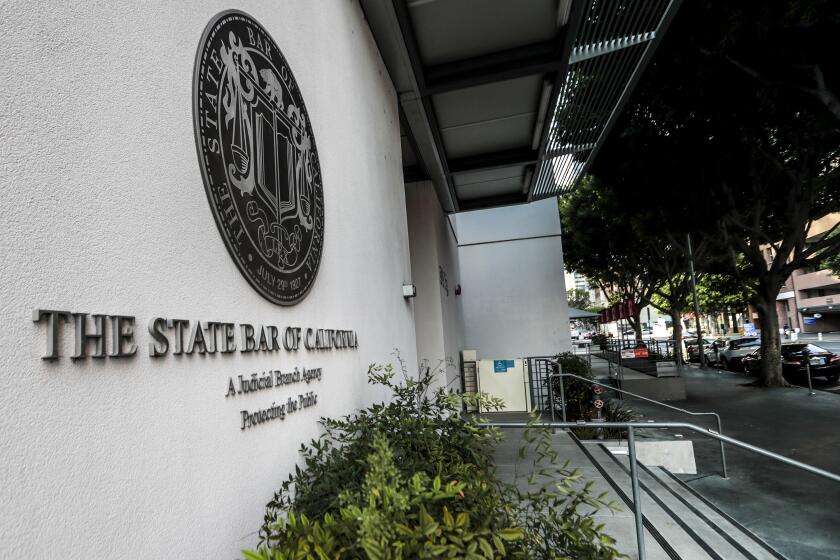Tracking the slow decline of the Pacific Electric Railway Red Cars
- Share via
The last Red Car rail line shut down in 1961.
But the iconic photo reflecting the decline of once-mighty rail in Los Angeles was taken 60 years ago.
It showed old Pacific Electric red cars sitting at a Terminal Island junkyard, set to become scrap metal.
After World War ll, the Pacific Electric Railway system was slowly dismantled — replaced by buses and freeways.
Sold for scrap
As reported in the March 19, 1956, Los Angeles Times, many of the cars were broken up for scrap:
A host of ghosts hovers over a monumental boneyard on Terminal Island in Los Angeles Harbor. There at the National Metal & Steel Corp. junkyard the hulks of hundreds of ancient streetcars are coming to rest at an acetylene torch-dissecting demise…
Currently some 200 old Pacific Electric red cars are piled three or four high in a mountain of rolling stock junk awaiting the searing knife flame of the torch.
The cars, most of which rolled to their doom on their own wheels down Harbor Belt Line tracks to the yard, are stockpiled near the water’s edge. One at a time gantry cranes lift them down to the waiting men with torches and huge alligator-jawed cutting machines…
After being dismantled, the scrap metal was sold locally or shipped overseas. The recycling continued for several years.
The slow decline
By then the rail system was already being dismantled. The Venice line was replaced by buses in 1950. The end of the era was marked by members of the Venice Lions Club, who performed a musical tribute to the old trains before going on one last ride to downtown.
Two years later, the Valley Red Car closed. In 1988, The Times looked back at its demise:
Despite the protests, the last Red Car to operate in the Valley — called “A Streetcar Named Expire” — made its final horn-tooting run in 1952.
“It was a sad day,” said cowboy Montie Montana, who, as honorary sheriff of the Valley, joined other dignitaries in riding the last Red Car.
“They should never have taken them out. You could ride downtown for a quarter and have no traffic.”
Off to Argentina
Not all of the old Red Cars were sold for scrap. In 1959, some used trolleys were shipped to Buenos Aires for use in a streetcar system in Argentina.
The Times reported that some of cars were placed on a ship bound for South America:
They were moved to the harbor from the old Subway Terminal tunnel near 4th and Hill Sts., where they had been stored since making their last trips on this county’s former network of suburban trackage.
Was it a conspiracy?
There were many reasons for the decline of both the Red Cars and L.A.’s Yellow Car trolley system. But one has gotten much attention: a conspiracy to replace rail with buses and cars. This was the plot to the movie “Who Framed Roger Rabbit.” The Times examined the facts in 2003:
In 1945, the Yellow Car system was sold to American City Lines, a subsidiary of National City Lines, a Chicago-based company whose investors included General Motors and other big oil and rubber interests.
Here is where the conspiracy theorists have a point.
National City Lines soon controlled 46 transit networks in the Midwest and West, including Los Angeles. The company began scrapping these electric systems and replacing them with diesel buses that — surprise — used fuel and rubber.
Clearly, L.A.’s electric-car days were numbered.
By 1946, the Justice Department had caught on. It filed an antitrust suit against National City Lines for conspiracy to monopolize the transit industry. But before the suit came to trial in Chicago, the consortium of big companies bailed out, selling their holdings in National City Lines. That essentially left it as an empty corporation.
In 1949, the case finally came to trial. The verdict was mixed, with acquittals and convictions. Although they no longer owned National City Lines, the companies in the consortium were fined wrist-slapping amounts of $5,000 each, while individual company officials were fined $1 each, for a total of $37,007. By then, the far-flung suburbs were crisscrossed by cars, highways and a few freeways, and the so-called conspiracy plot simply applied the coup de grace to a dying system.
In 1953, Pacific Electric sold its remaining Red Cars to a private bus line, which was bought out five years later by the state-owned Los Angeles Metropolitan Transit Authority for $33.3 million. The LAMTA scrapped the last Red Car in 1961, which was followed to the transit graveyard by the Yellow Car in 1963.
Even a Los Angeles transportation official declared, “The rail passenger operations of Pacific Electric became obsolete, and economically there was no justification for their perpetuation. As a result, like the horse and buggy, they dropped from the scene.”
Harrison is a former Times photo editor.
More to Read
Sign up for Essential California
The most important California stories and recommendations in your inbox every morning.
You may occasionally receive promotional content from the Los Angeles Times.










